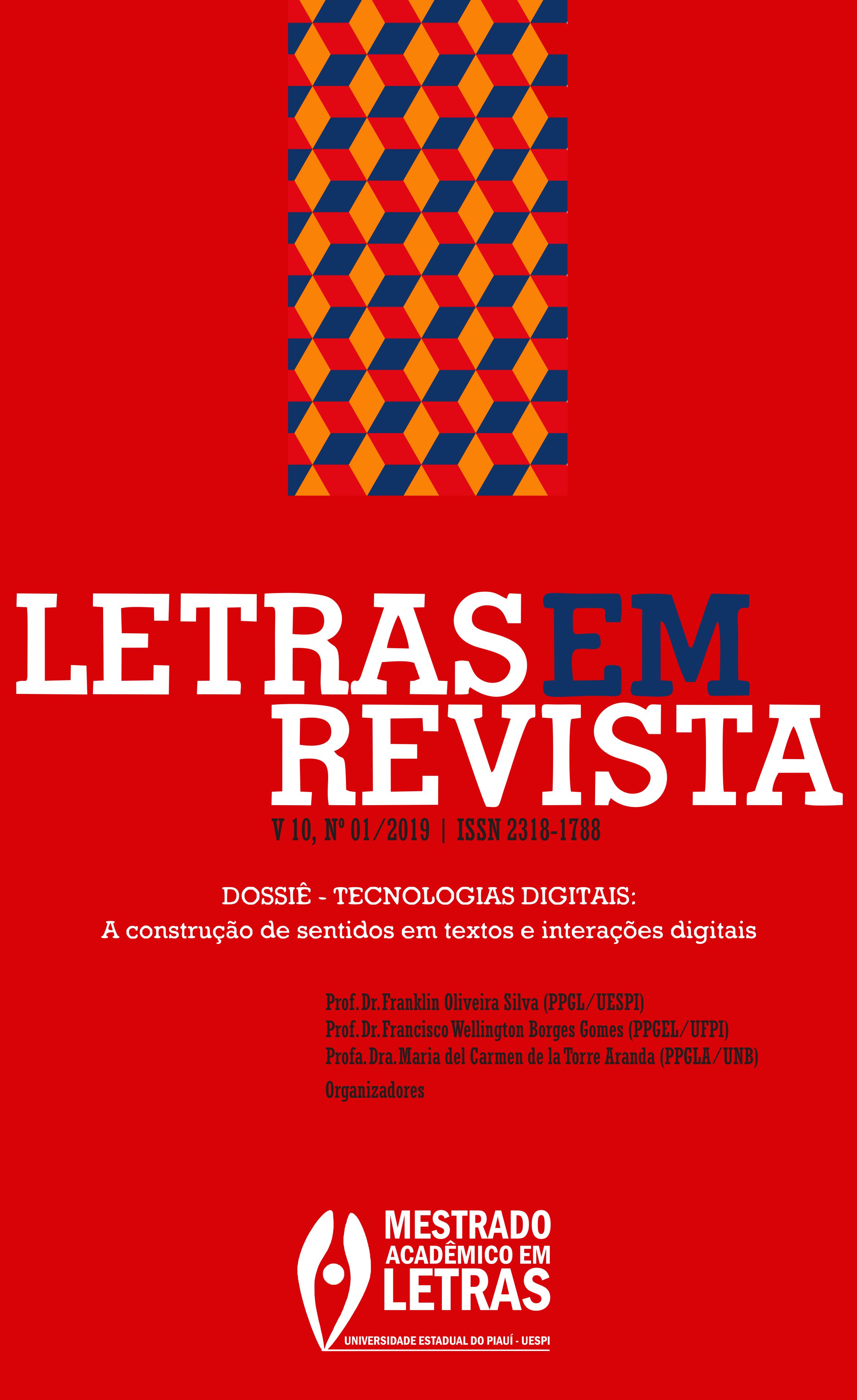Compreensão e retenção de informações na leitura de textos em meio impresso e digital
Resumo
Este estudo, de caráter quantitativo, buscou avaliar a compreensão e retenção de conteúdo lido em diferentes meios (impresso, computador de mesa, tablet e celular) de textos acadêmicos e jornalísticos. A pesquisa foi realizada com a participação de 37 alunos do Curso de Licenciatura em Letras com Habilitação em Língua Inglesa da Universidade Federal do Ceará. Os resultados encontrados nesta pesquisa corroboram a concepção de que não há diferenças significativas entre a leitura no meio impresso ou no meio digital. Também não verificamos melhor desempenho nos testes de compreensão aliados a nenhum dos quatro
meios utilizados (texto impresso, computador de mesa, tablet ou celular). Concluímos que não há evidências para receios em relação ao uso das tecnologias digitais para o ensino e aprendizado de línguas.
Referências
BARON, Naomi S. Words on screen: the fate of reading in a digital world. New York: Oxford University Press, 2015.
BERNARD, Tara S.; RUSSELL, Karl. How a New Tax Plan Could Affect Those With Student Debt. The New York Times. 11 de novembro de 2017. Disponível em: https://www.nytimes.com/interactive/2017/11/11/your-money/tax-student-debt.html.
Acesso em: novembro de 2017.
BEZDAN et al. The influence of node sequence and extraneous load induced by graphical overviews on hypertext learning. Computers in Human Behavior, May 2013, Vol.29, N.3, p.870-880.
BURGEN, Stephen; JONES, Sam. Catalan referendum: preliminary results show 90% in favour of independence. The Guardian. 02 de outubro de 2017. Disponível em: https://www.theguardian.com/world/2017/oct/01/dozens-injured-as-riot-police-storm-catalan-ref-polling-stations. Acesso em: outubro
de 2017.
BURT, M.; PEYTON, J. K.; ADAMS, R. Reading to learn. In: BURT, M.; PEYTON, J. K.; ADAMS, R. Reading and adult English language learners: A review of the research. Washington, DC: Center for Applied Linguistics. 2003, p. 33-36.
CARR, Nicholas. The Shallows. What the Internet Is Doing to Our Brains. New York, London: W.W. Norton & Company, 2010.
CHEN et al. Facilitating English-language reading performance by a digital reading annotation system with self-regulated learning mechanisms. Educational Technology e Society, Jan, 2014, Vol.17, N.1, p. 102.
COBB, Thomas. Reading and Technology: What’s New and What’s Old about Reading in Hyperlinked Multimedia Environments? In: HINKEL, Eli (Ed.). Handbook of Research in Second Language Teaching and Learning. Volume III. New York: Routledge, 2017, p. 312-327.
COLTHEART, Max. Modelando a leitura: a abordagem da dupla rota. In: SNOWLING, Margaret J.; HULME, Charles (orgs). A ciência da leitura. Porto Alegre: Penso, 2013, p. 24-41.
FESEL et al. Quality of children’s knowledge representations in digital text comprehension: Evidence from pathfinder networks. Computers in Human Behavior, Jul/2015, Vol.48, p.135-146.
FREUND, Luanne; KOPAK, Rick; O’BRIEN, Heather. The effects of textual environment on reading comprehension: Implications for searching as learning. Journal of Information Science Vol 42, n. 1, 2016, pp. 79 – 93. Disponível em: http://journals.sagepub.com.ez11.periodicos.capes.gov.br/doi/abs/10.1177/0165551515614472#articleCitationDownloadContainer. Acesso em: julho
de 2017.
HALL et al. Addressing Learning Disabilities With UDL and Technology. Learning Disability Quarterly, 2015, Vol.38, N.2, pp.72-83.
IHMEIDEH, Fathi M. The effect of electronic books on enhancing emergent literacy skills of preschool children. Computers and Education, Out/2014, Vol.79, p.40-48.
JONES, Rodney H. Digital Literacies. In: HINKEL, Eli (Ed.). Handbook of Research in Second Language Teaching and Learning. Volume III. New York: Routledge, 2017, p. 286-298.
JAN et al. Enhancement of digital reading performance by using a novel web-based collaborative reading annotation system with two quality annotation filtering mechanisms. International Journal of Human - Computer Studies, Fev/ 2016, Vol.86, p.81-93.
JIN, Sung-Hee. Visual design guidelines for improving learning from dynamic and interactive digital text. Computers and Education, Abril/2013, Vol.63, p.248(11).
KINTSCH, W. Comprehension: A paradigm for cognition. Cambridge: Cambridge University Press, 1998.
KLOIS et al. How hypertext fosters children’s knowledge acquisition: The roles of text structure and graphical overview. Computers in Human Behavior, Set/2013, Vol.29, N.5, p.2047-2057.
KOCH, I. V.; ELIAS, V. M. Ler e compreender os sentidos do texto. 2.ed. São Paulo: Contexto, 2008.
KORAT, Ofra ; SHAMIR, Adina. Direct and Indirect Teaching: Using e-Books for Supporting Vo cabulary, Word Reading, and Story Comprehension for Young Children. Journal of Educational Computing Research, 2012, Vol.46, N.2, p.135-152.
KUMARAVADIVELU, B. Language as discourse. In: KUMARAVADIVELU, B. Understanding language teaching: from method to postmethod. New Jersey: Lawrence Erlbaum Associates, 2006, p.07-11.
MCCLANAHAN et al. A Breakthrough for Josh: How Use of an iPad Facilitated Reading Improvement. TechTrends, 2012, Vol.56, N.3, p.20-28.
MYRBERG, Caroline; WIBERG, Nina. Screen vs. paper: what is the difference for reading and learning? Insights, Jul 2015, Vol.28(2), p.49-54.
SALMERÓN, Ladislao; GARCÍA, Victoria. Reading skills and children’s navigation strategies in hypertext. Computers in Human Behavior, 2011, Vol.27, N.3, p.1143-1151.
SCHNEPS et al. E-Readers Are More Effective than Paper for Some with Dyslexia. PLoS One, Set/2013, Vol.8(9), p.e75634.
SHANG, Hui-Fang. Online metacognitive strategies, hypermedia annotations, and motivation on hypertext comprehension. Educational Technology e Society, 2016, Vol.19, N.3, p.321(14).
STOOP, Judith; KREUTZER, Paulien; KIRCZ, Joost. Reading and learning from screens versus print: a study in changing habits: Part 1 – reading long information rich texts. New Library World, Vol.
114 Issue: 7/8, 2013, p.284-300. Disponível em: https://doi.org/10.1108/NLW-01-2013-0012. Acesso em março de 2018.
SULLIVAN, Sarah H; PUNTAMBEKAR, Sadhana. Learning with digital texts: Exploring the impact of prior domain knowledge and reading comprehension ability on navigation and learning outcomes. Computers in Human Behavior, Set/2015, Vol.50, p.299-313.
WARSCHAUER, M. Learning in the cloud: How (and why) to transform schools with technology. New York: Teachers College Press, 2011.
VÖRÖS et al, Effect of high-level content organizers on hypertext learning. Computers in Human Behavior, 2011, Vol.27, N.5, p.2047-2055.
ZENG et al. The Influence of E-book Format and Reading Device on Users’ Reading Experience: A Case Study of Graduate Students. Publishing Research Quarterly, Dec 2016, Vol.32, N.4, p. 319-330.





.jpg)



